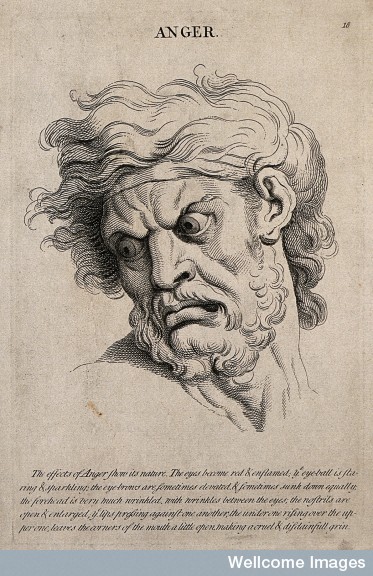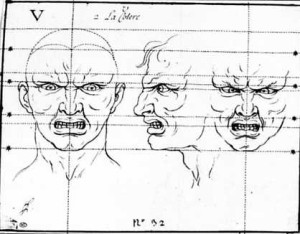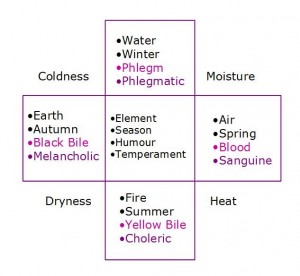
Changing Perceptions of Anger in the Eighteenth Century
A guest post by Dr Lina Minou

To draw an image of the physiology of anger in the eighteenth century was to draw an image on the verge of pathology. Representations of the human body in anger centre on notions of excess: excess of heat, excess of reaction – as in the loudness of voice – or excess in the form of distortion of the facial muscles. Indeed, one of the most usual health dangers associated with anger was an excess that could not be sustained by the body, which reacted by immediately arresting all function; an apoplexy.
Yet, for all its negative connotations, it would be a mistake to assume that anger was viewed as solely deleterious to the body. Physiological, and moral, discourse on this emotion was often characterised by multiple perspectives.1 For instance, by reading various types of medical texts between 1250 and 1700, Elena Carrera uncovered that, in addition to recognizing its harmful effects, texts provide widespread evidence for a therapeutic side of anger. More specifically, moderate anger was helpful in maintaining the body’s natural heat, whereas
an outburst of anger might be beneficial for people who are cold by temperament or as the result of poisoning or sickness.2
A provocation to anger was also considered useful to people of ‘weak nerves’. Behind this notion of beneficial anger was the principle of ‘curing by contraries’. Under the humoural paradigm (see the chart below) a person was never in an absolute state of health but rather in a continuous search for an ideal equilibrium of humours. This search for balance allowed for the idea of curing – that is, modifying a state, or the effects of a humour – by counteracting its qualities through its opposite. Anger which was thought to be hot and dry could be used to counteract, for example, excessive coldness and moisture and thus achieve a more balanced, healthier state.
After the 1700s medical writers continued to recognize curative effects in anger. In part this was due to repeating past therapeutic advice. Their wording, though, suggests a new physiological focus: that of motion and tension. Interspersed among references to convulsive disorders, frenzy, inflammations and fevers are comments that reveal a positive aspect of anger in promoting and maintaining a ‘brisker motion’ of the blood and invigorating the nerves. William Forster, writing in 1745, talked of how ‘terror strikes men dumb and palsical and how anger cures them’; he went on to explain that this cure relied on reversing the effects of obstructed motion.3 In 1746 he added that people prone to anger were capable of bearing fatigue as the emotion allowed the ‘spirits to move freely into the fibres everywhere’ keeping them ‘constantly supplied and in the proper degree of tension’.4
Another author, Theophilus Lobb, in 1734 wrote that
anger [among other passions] moderately exercised, will maintain a due briskness in the motion of the nervous fluid, a sufficient strength in the vibration of the solids, and a just quickness in the contractions, and dilations of the hearts and arteries, and in the circulation of the blood’.5
James Mackenzie noted that ‘moderate joy and anger […] invigorate the nerves, accelerate the circulating of fluids, promote perspiration, and assist digestion’.6

Credit: Wellcome Library, London.
By the time of these writings definitions of health and disease had been modified. For the new mechanical theory health depended on a regular, orderly, and unobstructed motion of fluids as well as an appropriate tension and tone of the fibres and nerves that helped sustain this motion. Accordingly, the benefits of anger now related, not to heat, but to qualities that facilitated motion. Notice, for instance, all the active and action words related to anger: ‘accelerate’, ‘invigorate’, ‘stimulate’, ‘strength’. Along with change, however, there was also continuity. As is obvious from these quotes the principle of opposition persisted in the new health model. The difference lay in what exactly was being opposed: celerity of motion to sluggishness, or tendency to laxity of nerves. Anger was still seen as ‘curative’ as it provided certain well-defined benefits.
By the end of the century the potentially beneficial side of anger was abandoned. This was no accident as a new way of thinking about the body was progressively introduced from the 1740s. The dominant physiological model aimed to show that living matter was organized differently from inanimate matter. A good way to exemplify this was to focus on how living matter responded to stimuli, both physical and mental. The eighteenth century had an important word that signified that innate capacity for reaction: ‘sensibility’. But sensibility was not only related to sense, and thus the body, but also to sensitivity, to morality, to compassion and other concepts. The same applied to ‘sympathy’ another important keyword. It applied both to a mental process and a physical one as in sympathy – that is, communication, interaction – of the organs in the body. Under this model, the increased heart rate of anger was not discussed primarily in terms of heat or motion, and their potentially beneficial qualities, but it became a ‘proof’, an illustration of the workings and the interconnections of the living matter itself.
The dominant health vocabulary now rested on terms that were expansive, that could mean several things at once that brought together the physical, the mental and the moral. The therapy that followed it did not rely on balance and opposition in the same transparent way that the previous two models had. In other words, there was no clear purpose to inciting regulated anger, no clearly articulated benefit for increased heat or increased motion. As a result anger lost its capacity to be therapeutic.
Today we still recognize a beneficial aspect to anger: one that is usually couched in psychological terms and originates in the notion of anger as a reaction to injury. Physiologically, in our post-neuroscience world, we do not view anger as opposing something in particular. However, there still persists a notion of anger as strength-inducing and motivating. Part of the vocabulary we have when talking about this aspect of anger derives from this heritage of beneficial anger.
Dr Lina Minou completed her PhD thesis at Loughborough University in 2014. Her thesis considered aspects of eighteenth–century literature and culture. She is particularly interested in the history of ideas and the history of morally objectionable emotions. Lina has a chapter entitled ‘”To Take Ill’: Resentment in Eighteenth-Century Context’ in On Resentment: Past and Present, ed. by Bernandino Fantini, Dolores Martin Moruno and Javier Moscoso (Cambridge Scholars Publishing, 2013).
_____________________________
1 See for example: Suzanna Braund and Glenn W. Most (eds), Ancient Anger: Perspectives from Homer to Galen (Cambridge University Press, 2003), Barbara Rosenwein (ed.), Anger’s Past: the Social Uses of an Emotion in the Middle Ages (Cornell University Press, 1998).
2 The quotation comes from an earlier blog post: Elena Carrera, ‘The Uses of Anger in Medieval and Early Modern Medicine’, The History of Emotions blog < www.qmul.ac.uk/emotions> [accessed 24 January 2014] see the published, expanded version in Elena Carrera, ‘Anger and the Mind-Body Connection in Medieval and Early Modern Medicine’, in Emotions and Health 1200-1700, ed. by Elena Carrera (Brill, 2013), pp. 95-146.
3 William Forster, A Treatise on the Causes of Most Diseases Incident to Human Bodies, and the Cure of Them (Leeds, 1745), p.112.
4 Forster, A Treatise (London, 1746), p.352.
5 Theophilus Lobb, Rational Method of Curing Fevers: Deduced from the Structure, and Oeconomy of Human Bodies (London: Printed for John Oswald, 1734), p. 105.
6 James MacKenzie, The History of Health and the Art of Preserving it (Edinburgh: Printed by William Gordon, 1758), p. 389. It is also interesting to note that beneficial anger in physiology appears close to moderate joy and its effects, a pairing that goes against the traditional groupings of the passions.






2 thoughts on “Understanding Anger”
Comments are closed.